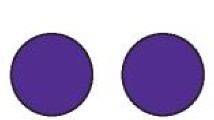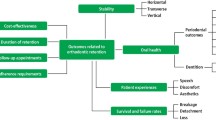Key Points
-
Investigates whether the introduction of the qualified orthodontic therapist has influenced treatment outcomes.
-
Provides reassurance of quality of work of the orthodontic therapist working under direct supervision of an orthodontic specialist.
-
Highlights excellent standards of treatment within primary care.
Abstract
Objective To assess the effect of the introduction of orthodontic therapists (OTs) on the quality of orthodontic treatment outcomes in two specialist orthodontic practices in the UK.
Study design Retrospective cross sectional observational study.
Setting Multi-centre evaluation at two specialist orthodontic practices in Yorkshire. Data collection was carried out during 2014.
Materials and methods The treatment undertaken by three specialist orthodontic clinicians (A, B and C) was evaluated at two time points. The first time point (T1) was before the introduction of OTs when the specialist orthodontic clinicians were solo operators. The second time point (T2) followed the introduction of OTs. Patients at T2 had their treatment planned by a specialist orthodontist and were seen for care by both the orthodontist and an OT who had been qualified for a minimum of three years. A sample size of 30 orthodontic patients per clinician at each time point was chosen. Included participants had completed a course of fixed appliance therapy. They were consecutively selected from cases that had been completed in the specified time frame for each clinician.
Main outcome measures The quality of treatment was assessed objectively using the quantitative Peer Assessment Rating index (PAR index). Data extracted from the specialist practice databases also allowed conclusions to be drawn about the length of treatment time and number of appointments in each treatment group.
Results and conclusions There appears to have been no change in orthodontic treatment outcomes following the introduction of supervised OTs at two specialist orthodontic practices.
Similar content being viewed by others
Introduction
Access to healthcare is an increasingly challenging issue of public policy.1 In the field of dentistry, an improved dentist-to-patient ratio has been suggested as one way to address this problem, whilst some advocate the delegation of certain tasks to dental care professionals (DCPs) – dental nurses, dental hygienists, dental therapists, orthodontic therapists, dental technicians and clinical dental technicians.2 The aims of both of these approaches are to improve treatment standards, productivity and efficiency.
One of the major changes in orthodontics over the last decade has been an increase in the orthodontic workforce due to the introduction of orthodontic therapists (OTs). This has led to improved access to specialist-led orthodontic care. In addition to improving access to and altering the skill mix of the orthodontic team, utilisation of OTs has lowered the cost of supply of orthodontic treatment.3
In 1995, a pilot study to investigate the training requirements of orthodontic auxiliaries was undertaken at Bristol Dental School.4 The results of this initial study exceeded even the course co-ordinators' expectations and has since formed the basis of the current educational programme.4,5 The OT curriculum was approved in 2002 by the GDC and specific training requirements have since been outlined to ensure standardised education throughout the UK.6 There are currently eight OT courses recognised and monitored by the GDC, each roughly conforming to the original programme design. The trainee has an introductory period based at the school followed by an extended phase in workplace training under the close supervision of the trainer; either in specialist practice or the hospital setting. Following satisfactory completion of assessments and clinical activity, the OT is eligible to sit the examination for the diploma in OT examination.7 Several authors have investigated the impact of clinician designation on orthodontic treatment outcomes and have reported poorer outcomes for dentists with no formal training compared to those trained as orthodontic specialists.8,9,10 To date there have been no studies evaluating the treatment undertaken by OTs.
The Peer Assessment Rating
The Peer Assessment Rating (PAR) index was developed to enable the objective measurement of orthodontic treatment outcomes by analysing both pre- and post-treatment orthodontic study models. Two scores are generated which allow comparisons to be made between the start malocclusion and the resulting occlusion following orthodontic therapy.11 The greater the reduction in score between the start and finish, the better the result achieved. The PAR nomogram is used to determine the percentage reduction between the start and finish study models. This index has been validated and proven for its reliability.12
The aim of this study is to assess the effect that the introduction of the OT has had on the quality of orthodontic treatment outcomes as measured by the PAR index and duration of treatment.
Method
A retrospective, cross-sectional observational study was undertaken at two specialist orthodontic practices in Yorkshire. Treatment was undertaken by three specialist orthodontic clinicians (A, B and C) and was evaluated at two time points using the PAR index. The first time point (T1) was prior to OT involvement in patient care. It represented the time immediately before the respective clinician began working with any OT and the required number of consecutively completed cases was calculated working back from this point. For clinicians A and B, who worked at the same specialist orthodontic practice, T1 represented the timeframe April 2007 to June 2007. Matched dates at T1 were unavailable for clinician C as their employment began in April 2008. Clinician C had a total of 36 finished cases for the financial year of 2009, prior to them working with an OT, and as such the full year was needed for adequate recruitment. The second time point (T2) included patients treated with the assistance of the OT and represented a time frame of April 2013 to June 2013. These dates were chosen as the last therapist had completed their training in April 2010 and these dates were immediately before a further OT student commenced training in July 2013. The OTs included in the study all had at least three years of post-qualification experience and were not in training during the treatment period of cases completed at T2. All clinical work undertaken by the OTs occurred with the supervising orthodontists in attendance seeing each patient at the outset of each appointment, which is the policy within both of the specialist orthodontic practices.
Ethical approval was sought and given by the NRES Committee West Midlands-Coventry and Warwick.
In view of the fact no similar study had previously been conducted it was not possible to carry out a power calculation so a sample size of 30 patients per clinician at each time point was proposed by a statistician.
Initial patient selection involved identifying patients who had received orthodontic treatment. This was achieved by analysing archived laboratory invoices detailing the patients who had received retainers following treatment. Patient databases at the respective orthodontic practices allowed further assessment of the participant's eligibility by applying exclusion criteria. If the patient did not fulfil the inclusion/exclusion criteria (Table 1) the subject was removed from the study and the next consecutive patient was recruited until the sample size of 30 was reached.
The primary outcome measurement for the study was quantified as occlusal change from pre- and post-treatment dental casts using the PAR index. Secondary outcome measures included the time taken to complete treatment and the number of appointments incurred. This data was gathered from the orthodontic practice patient administration software at both sites.
Data analysis
Descriptive statistics were used to calculate the central tendency and spread. Control for confounding factors was carried out by using a multivariate regression analysis. The relationship between T1 and T2 was examined using Mann-Whitney U Test. Intra-examiner reliability was tested by repeating the examination of a computer-generated random sample of 10% of cases. Two calibrated examiners also examined the same sample to assess inter-examiner reliability using the intra-class correlation coefficient. The reliability testing was carried out one month after the initial data collection to allow for a wash out period.
Results
Data collection was undertaken from August to November 2014 at two specialist orthodontic practices in Beverley and Sheffield. One hundred and sixty eight patient dental casts were identified and analysed. At T1, clinicians A and B had a complete set of 30 dental casts for analysis; only 18 complete dental casts were available for analysis for clinician C. A full complement of dental casts (N = 30) was available for evaluation for each clinician (A, B and C) at time point T2.
Of the 168 participants included in the study, 100 were female and 68 were male. There was a similar distribution of gender between the two groups. The mean age of the study participants was 13.96 years with a standard deviation (SD) of 1.452.
Most of the treatment undertaken was fixed appliance therapy with extractions (36%). The least used treatment modalities were rapid maxillary expansion with or without extractions and canine exposure without extractions (each representing <1% of the data). Table 2 shows the different types of treatment undertaken.
The percentage of time spent with OTs was 0% for all participants at T1. At T2 mean percentage of treatment undertaken by the therapist was 56%, 95% CI (52.36, 59.57). Descriptive statistics are shown in Tables 3 and 4 with respect to outcome measures.
The overall median for PAR score point reduction was 24 and the range was 53. The maximum point reduction was 58 and the minimum was five. The overall median for %PAR score point reduction was 90% and the range was 66%. The maximum %PAR reduction was 99% and the minimum was 33%.
Non-parametric testing was also undertaken between T1 and T2. No statistically significant difference was found between T1 and T2 with respect to all outcome measures at the significance level of P = 0.05 using the Mann-Whitney U Test.
Multivariate regression analysis was used to show how each variable influenced treatment outcome. For treatment time, the number of appointments was the only variable which had a statistically significant impact on the outcome measure (P = <0.001). The number of appointments was affected by a larger range of variables; age (P = 0.008), month (P = <0.01) and %PAR score change (P = 0.016). PAR score change was affected only by variables intrinsically linked to the outcome measure; pre-PAR score (P <0.001), post-PAR score (P <0.001) and %PAR score change (P <0.001). Percentage PAR score change was affected by the greatest number of variables; age (P = 0.027), number of appointments (P = 0.016), pre- PAR score (P = 0.001), post- PAR score (P <0.001) and PAR score (P <0.001).
The reliability of the PAR measurements assessed using intra-class correlation coefficient (ICC) is shown in Table 5.
Discussion
The results show that there appears to have been no change in orthodontic treatment outcomes following the introduction of supervised OTs at two specialist orthodontic practices. No statistically significant difference was found between the two groups with respect to the treatment time, number of appointments, PAR score change and %PAR score change at the significance level of P = 0.05.
Participant demographics showed a 3:2 female:male ratio. This is likely due to an increase in uptake of orthodontic treatment for female patients.13 Shaw hypothesised this may be due to the increased emphasis placed on female attractiveness in society.14 The age range between the two groups was comparable but the distribution of the data was not. T2 had a normal distribution whereas T1 was positively skewed. This may be due to a reduced number of participants in T1 compared to T2. Alternative reasons for the difference in age distribution may be due to external confounding factors such as that of supply and demand at the time of treatment or the influence of the media. It has been suggested that the media may play a part in the increased numbers of adult patients seeking orthodontic treatment.14 Treatment modality and pre-/post-treatment PAR scores were comparable between T1 and T2. Results showed that patients treated with the assistance of OTs had a similar need for treatment as those treated prior to the introduction of OTs. All clinicians utilised OTs routinely; on average, 56% of patients were treated with the OT. Although the British Orthodontic Society have made recommendations that clinicians should supervise the OT at least every other visit,15 there were no unsupervised patient visits in this study. The positive findings from this study showing no difference between the two study groups may, therefore, not be generalisable to the unsupervised OT working under written prescription only.
Multivariate regression analysis provided some evidence to support opposition for the use of the PAR index as a treatment outcome measure. Certain treatments such as unerupted ectopic canines that may take a long time to align do not appear to be a factor in predicting PAR score or %PAR score reduction. Length of treatment did, however, show an inverse correlation with age, with older patients requiring fewer appointments. This may be due to the improved co-operation of the older age group presenting less frequently for orthodontic repairs.
Intra- and inter-examiner reliability was found to be excellent resulting in intra-class correlation coefficients of greater than 0.74 for both PAR score change and %PAR score change.16
Treatment failing to achieve over 70% PAR score reduction was investigated further to identify the reason for sub-optimal outcome (Table 6). Eleven out of 168 dental casts evaluated had the PAR score % reduced by less than 71%. However, using the PAR nomogram only 95 treatments (57%) would have been considered greatly improved and 73 treatments (43%) would have been allocated to the 'improved' category.17 A PAR score reduction of less than 22 points cannot be considered greatly improved. No treatment scored less than 30% (which would fall into the 'worse/no different' category). Where sub-optimal PAR scores were achieved, the reasons are detailed in Table 6.
Conclusions
There was no change in orthodontic treatment outcomes following the introduction of OTs at two specialist orthodontic practices as measured by the following treatment outcomes:
-
Length of time
-
Number of appointments
-
PAR score change.
This study highlighted excellent standards of treatment, with PAR scores showing 57% of cases were greatly improved, 43% improved and none were worse or no different. However, it should be noted that the results from this service evaluation of PAR score reductions reflects the technical abilities of individual clinicians and their appropriate involvement in the treatment of patients with the OT. It may not be achievable for all dentists undertaking orthodontic treatment with or without an OT and it is also important to note that the OTs in this study had 100% supervision at each patient contact. Therefore, these results cannot be generalised to the OT who is only supervised part-time.
References
Braine T . More oral health care needed for ageing populations. Bulletin of the World Health Organization. 2005; 83: 646–647.
Evans C, Chestnutt I, Chadwick B . The potential for delegation of clinical care in general dental practice. Br Dent J 2007; 203: 695–699.
Hodge T . Orthodontic Therapists and their Integration into the Orthodontic Team. Orth Update 2015.
Stephens C, Keith O, Witt P, Sorfleet M, Edwards G, Sandy J . Orthodontic auxiliaries-a pilot project. Br Dent J 1998; 185: 181–187.
Anderssohn M, Barnett D, Jones S, Oliver R, Postlethwaite K, Stephens C . The joint response of the British Orthodontic Societies to the Nuffield Inquiry into personnel auxiliary to dentistry. Br Dent J 1993; 174: 182–183.
GDC. Developing the dental team. Second edition. 2009. Available online at http://www.gdc-uk.org/dentalprofessionals/education/documents/developingthedentalteam.pdf (accessed September 2016).
RCSEng. http://www.rcseng.ac.uk/fds/courses/orththerapy (accessed September 2016). (URL does not exist. Please correct)
Richmond S, Shaw W C, Roberts C T, Andrews M . The PAR Index (Peer Assessment Rating): methods to determine outcome of orthodontic treatment in terms of improvement and standards. Euro J Ortho 1992; 14: 180–187.
Timmins N . NHS goes to the PROMS. BMJ 2008; 336: 1464–1465.
OED. Oxford English Dictionary 'index, n.': Oxford University Press; 2014 Available online at http://www.oed.com/view/Entry/94372?rskey=flJ1Ds&result=1 (accessed September 2016).
Templeton K, Powell R, Moore M, Williams A, Sandy J . Are the Peer Assessment Rating Index and the Index of Treatment Complexity, Outcome, and Need suitable measures for orthognathic outcomes? Euro J Orth 2006; 28: 462–466.
Bergstrom K, Halling A . Comparison of three indices in evaluation of orthodontic treatment outcome. Acta Odont Scand 1997; 55: 36–43.
Shaw W C, Richmond S, O'Brien K D, Brook P, Stephens C D . Quality control in orthodontics: indices of treatment need and treatment standards. Br Dent J 1991; 170: 107–112.
Shaw W C, Richmond S, O'Brien KD . The use of occlusal indices: a European perspective. Am J Orthod Dentofacial Orthop 1995; 107: 1–10.
Angle EH . Classification of malocclusion. Dent Cosmos 1899; 41: 248–264.
Houston WaT, J . A Textbook of Orthodontics. 2nd ed. Oxford: Butterworth Heinemann, 1993.
BSI. BS4492, British Standard Glossary of Terms Relating to Dentistry. British Standards Institution: London, 1983.
Acknowledgements
The authors would like to thank Trevor Hodge, Jon O'Dwyer and Dave Tinsley at Orthodontic Centre Sheffield and Beverley for their permission to examine records of patients under their care, the dental nurses for their help with data collection and Jing Kang for her statistical input.
Author information
Authors and Affiliations
Corresponding author
Additional information
Refereed Paper
Rights and permissions
About this article
Cite this article
Rooney, C., Dhaliwal, H. & Hodge, T. Orthodontic therapists – has their introduction affected outcomes?. Br Dent J 221, 421–424 (2016). https://doi.org/10.1038/sj.bdj.2016.735
Accepted:
Published:
Issue Date:
DOI: https://doi.org/10.1038/sj.bdj.2016.735



